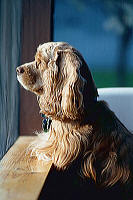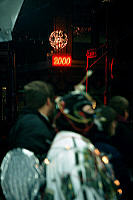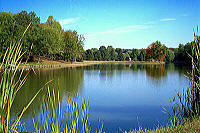 Theoretically
a lens only focuses to an exact distance. Any object at that exact
distance will be in sharpest possible focus. Any object closer or
farther will not be in sharpest possible focus, but something less than
that. We cannot perceive that an object is out of focus until the
degradation falls to some level below the sharpest possible focusing.
Thus we perceive a range of distances roughly centered around the exact
focus distance that appear to be in focus. Depth of Field (DOF) is
the distance in front of the exact focus distance plus the distance behind
that point that appear to be in focus. That is, we will not perceive
them as out of focus. Objects outside this range will be visibly
out of focus. This section discusses how to creatively use and exploit
the DOF characteristics of a lens in composing a photograph. Technical
discussion about how to compute the specific DOF for a particular focal
length and aperture, based on accepted definitions of what constitutes
"acceptable focus" is covered by the "Science of Photography" in the DOF
subsection under the Lens section.
Theoretically
a lens only focuses to an exact distance. Any object at that exact
distance will be in sharpest possible focus. Any object closer or
farther will not be in sharpest possible focus, but something less than
that. We cannot perceive that an object is out of focus until the
degradation falls to some level below the sharpest possible focusing.
Thus we perceive a range of distances roughly centered around the exact
focus distance that appear to be in focus. Depth of Field (DOF) is
the distance in front of the exact focus distance plus the distance behind
that point that appear to be in focus. That is, we will not perceive
them as out of focus. Objects outside this range will be visibly
out of focus. This section discusses how to creatively use and exploit
the DOF characteristics of a lens in composing a photograph. Technical
discussion about how to compute the specific DOF for a particular focal
length and aperture, based on accepted definitions of what constitutes
"acceptable focus" is covered by the "Science of Photography" in the DOF
subsection under the Lens section.
Selective Focus
 How
much depth of the photograph is in focus depends on three factors:
How
much depth of the photograph is in focus depends on three factors:
- Focal Length: The longer the focal length of a lens, the shallower the DOF will be for a given aperture and focus distance. Telephoto lenses will have shallower DOF than wide angle lenses for a given aperture and focus distance.
- Aperture: The wider the aperture, the shallower the DOF will be for a given focal length and focus distance.
- Focus Distance: The shorter the focus distance, the shallower the DOF will be for a given focal length and aperture.
If the subject itself contains any depth, a pitfall of selective focus is attempting a shallow DOF too extreme which leaves a portion of the subject out of focus. Understanding one's lenses and having a feel for combinations of focal lengths and apertures that can be used for selective DOF while leaving enough depth for the subject requires practice and experience. Just as bracketing with exposure under complex lighting situations is often recommended, bracketing with several aperture settings (while adjusting the shutter speed accordingly) also works for achieving the proper DOF.
Most manual focus lenses have DOF markings for specific apertures. These can be used, but experiments to determine their accuracy and if they produce the desired effects are recommended first. Most of these lenses also have a DOF preview switch or button that will stop the lens down to the selected aperture. This can also help determine the approximate aperture required for the desired DOF provided there is enough light to see the foreground, subject and background clearly with the lens stopped down.
Bokeh
 Bokeh
is a Japanese term used to describe the portion of an image that is perceptibly
out of focus. A lens with "good" bokeh will produce a soft fuzzy
edge to objects out of focus. If the object includes a pinpoint light
source, the pinpoint highlight will appear as a soft edge fuzzy circle.
Several pinpoints close together may produce overlapping soft fuzzy circles.
"Bad" bokeh can be caused by a number of phenomena. It may have a
harsh (versus soft and fuzzy) edge, or it may be a distinct polygon in
the shape of the aperture (usually 6 or 8 blades producing a hexagon or
octagon). "Coma" is a lens damage, build flaw or design shortcoming
that causes out of focus points to produce a slight tail also giving them
a shape similar to a coma. Any combination of these effects causes
the bokeh to be harsher than the ideal fuzzy edge circle.
Bokeh
is a Japanese term used to describe the portion of an image that is perceptibly
out of focus. A lens with "good" bokeh will produce a soft fuzzy
edge to objects out of focus. If the object includes a pinpoint light
source, the pinpoint highlight will appear as a soft edge fuzzy circle.
Several pinpoints close together may produce overlapping soft fuzzy circles.
"Bad" bokeh can be caused by a number of phenomena. It may have a
harsh (versus soft and fuzzy) edge, or it may be a distinct polygon in
the shape of the aperture (usually 6 or 8 blades producing a hexagon or
octagon). "Coma" is a lens damage, build flaw or design shortcoming
that causes out of focus points to produce a slight tail also giving them
a shape similar to a coma. Any combination of these effects causes
the bokeh to be harsher than the ideal fuzzy edge circle.
Not all lenses have "good" bokeh. This does not mean a lens with "bad" bokeh is a "bad" lens. It may have other characteristics in which it excels and is particularly useful. All lens designs have some trade-offs among a half dozen desirable characteristics. Understanding how a lens behaves with portions of the image out of focus is important when attempting selective focusing. A couple of subtle techniques can be used to pull an acceptable bokeh out of a lens that inherently exhibits harsh bokeh. One technique is to attempt using the lens at its widest aperture. Most lenses fully retract the aperture blades at widest aperture making the lens barrel and its internal flanges that hold the lens groups the effective aperture diaphragm. Since a lens barrel and its internal flanges are round, this can be used to eliminate distinct polygonal shapes from pinpoint highlights. Another techniques is selecting a background that does not have pinpoint highlights, or at least pinpoint highlights so close together the majority of the out of focus shapes overlap adjacent ones. This creates a blurred line or streak which can tolerate shapes other than round more easily.
Hyperfocal Focus
 This
subsection discusses how to creatively use and exploit hyperfocal DOF characteristics
of a lens. Technical discussion about how to compute the specific
hyperfocal DOF for a particular focal length and aperture, based on accepted
definitions of what constitutes "acceptable focus" is covered by the "Science
of Photography" in the DOF subsection under the Lens section.
This
subsection discusses how to creatively use and exploit hyperfocal DOF characteristics
of a lens. Technical discussion about how to compute the specific
hyperfocal DOF for a particular focal length and aperture, based on accepted
definitions of what constitutes "acceptable focus" is covered by the "Science
of Photography" in the DOF subsection under the Lens section.
Hyperfocal focusing has the opposite goal of selective focusing. The objective is having as much of the image as possible in focus. This technique is most often employed with scenic or architectural photography when the entire scene is the subject and the photographer desires all of it in acceptably sharp focus. Another less common situation is subject elements in the extreme foreground and background. All common camera lenses have an "infinity" focus. Since the DOF for a given focal length and aperture encompasses some distance behind and in front of the focus distance that will be perceived as in focus, setting a lens to "infinity" gives sharpest possible focus to extremely distant objects with degradation increasing as distance from the camera lens decreases. If the focus point is set to some distance slightly less than infinity then distances closer to the camera will be in acceptable focus but "infinity" will still be in acceptable focus. The hyperfocal point for a given focal length and aperture is the shortest (or closest) focusing point less than infinity that still barely has "infinity" in acceptable focus. This focusing point (for a specific focal length and aperture) also gives the greatest absolute DOF. The maximum DOF for a specific lens is achieved by focusing at the hyperfocal distance for its smallest aperture. For scenes with objects of interest that are desired to be in focus both very close and very distant, using the smallest aperture possible and focusing at the hyperfocal distance will create an image with the greatest absolute DOF.
There are three pitfalls in using the hyperfocal distance. The first is using the DOF markings on a lens and setting the edge of an aperture's DOF marking at the infinity marking. These markings are not always accurate. Computation using the formulae in the Lens Section of the "Science of Photography" and comparison with a specific lens markings is recommended. The second is the smallest aperture for most lenses. It pushes into the edge diffraction limits about the aperture diaphragm which can cause some slight sharpness degradation. In 35mm format with a 50mm standard lens, this is typically f/16. For long telephotos, such as 300mm, it may be as small as f/32 as the diffraction limit is related to absolute aperture diameter not the f-stop number. Optimal sharpness may be one half or one stop wider than the smallest aperture. Finally, what was perceived as acceptably focused at one size of print or projection (for slides) may show some focus degradation as the size of print or projection is increased. Knowing how much the final print or projection is likely to be can help with how conservatively the actual focus point is pushed closer to the camera from the infinity setting.